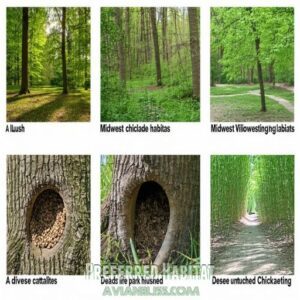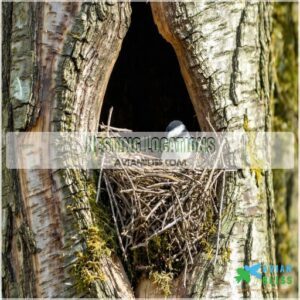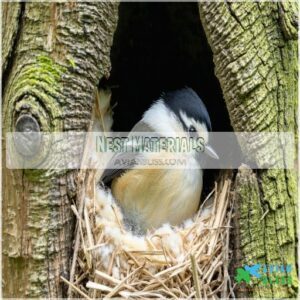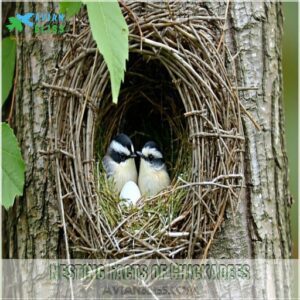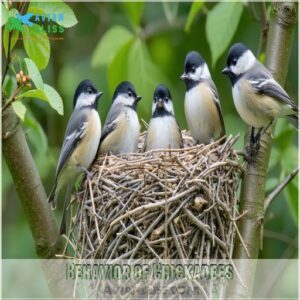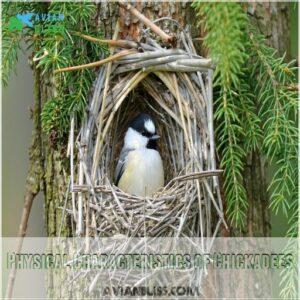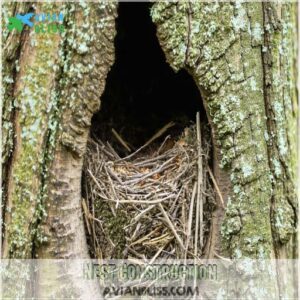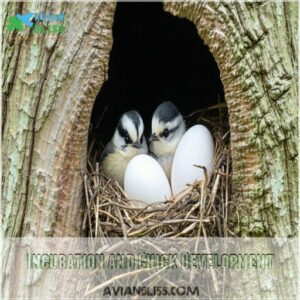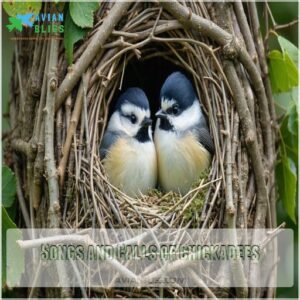This site is supported by our readers. We may earn a commission, at no cost to you, if you purchase through links.

They’ll typically choose tree cavities, abandoned woodpecker holes, or nest boxes between 4-15 feet high in deciduous and mixed forests.
You’ll find their nests carefully crafted with wood shavings, moss, and soft rabbit fur, creating a warm nursery for 6-8 eggs.
Chickadees are dedicated parents, with both partners sharing incubation and feeding duties during the 12-13 day egg period and 12-16 day nestling stage.
These small birds adapt brilliantly to various environments, from woodland edges to urban parks, making their nesting strategies a proof of nature’s resourcefulness.
Table Of Contents
- Key Takeaways
- Habitat and Nesting Habits of Chickadees
- Nesting Facts of Chickadees
- Behavior of Chickadees
- Conservation of Chickadees
- Physical Characteristics of Chickadees
- Life Cycle of Chickadees
- Tips for Attracting Chickadees to Your Backyard
- Seasonal Behavior of Chickadees
- Songs and Calls of Chickadees
- Nesting Habits and Tips for Chickadees
- Frequently Asked Questions (FAQs)
- Where do chickadees make their nests?
- What month do chickadees lay eggs?
- Do chickadees return to the same nest?
- What does a chickadee nest and eggs look like?
- What materials do chickadees use for nesting?
- Do chickadees reuse their old nests?
- Can I safely move a chickadee nest?
- How long do baby chickadees stay hidden?
- Will chickadees abandon their nest if disturbed?
- Conclusion
Key Takeaways
- You’ll find chickadees masterfully crafting their nests in tree cavities, abandoned woodpecker holes, or nest boxes, typically 4–15 feet high in deciduous and mixed forests, demonstrating their adaptability to various environments.
- When building their nests, they are meticulous architects, carefully selecting soft materials like moss, wood shavings, and rabbit fur to create a warm, protective nursery for 6–8 eggs, with both parents sharing incubation and feeding duties.
- You can support chickadees by maintaining forest edge habitats, setting up appropriate nest boxes with 1 1/8-inch entrance holes, and providing food sources like black oil sunflower seeds and suet to help these resilient birds thrive.
- Chickadees exhibit remarkable survival strategies, including forming winter flocks, using complex communication through their distinctive calls, and adapting to both natural woodlands and human-modified environments, which has helped maintain their stable population of 43 million birds.
Habitat and Nesting Habits of Chickadees
You’ll find chickadees in deciduous and mixed forests.
They prefer tree cavities or nest boxes to safely raise their young.
Their nests, often lined with moss and soft materials like rabbit fur, are carefully built to protect eggs and chicks from predators. This is where they raise their young in safety.
Preferred Habitat
Chickadees thrive in diverse settings, especially near forest edges.
Where do Midwest chickadees nest? They’re often found in habitats rich with tree cavities and mature trees.
Their top spots include:
- Open woods with natural cavities.
- Parks offering varied structures.
- Willow thickets for dense cover.
- Areas with minimal human impact.
Nesting Locations
Witnessing chickadee nest building is fascinating. These tiny architects choose nesting locations carefully, considering safety and food sources.
Where do midwest chickadees nest? Often, you’ll find chickadee nests in natural cavities like abandoned woodpecker holes or tree hollows. Nest site height varies, but they often prefer spots 1-7 meters up.
They’ll also readily use nest boxes; nest box design should mimic natural cavities. Nest cavity size matters; the birds excavate their own cavities, if needed.
Common nest tree species include alder and birch. Smart chickadees! They even consider nest predator defense when choosing a nesting location.
Nest Materials
Building the perfect home takes care, and chickadees are experts at it. They layer their nests with materials that blend durability and softness for comfort and safety. If you’re interested in supporting these amazing birds, you can find Chickadee Nest Materials online to create a welcoming environment.
Here’s how they do it:
- Base Layer: Excavated wood shavings and moss form the sturdy base within their chosen cavity.
- Inner Cushioning: Soft rabbit fur and fine materials insulate and protect delicate eggs.
- Purposeful Selection: Each piece is carefully chosen for its role – cushioning eggs, maintaining warmth, and enabling a cozy nest depth.
This blend of materials showcases nature’s craftsmanship!
Nest Height
Regarding their nests, chickadees keep things versatile. They’ll settle at different heights, depending on factors like safety and insulation. Generally, nests are found 4 to 15 feet above ground, though some go higher or closer to the earth. Elevated spots help avoid predators, while lower, decayed trunks offer warmth.
Here’s a quick comparison of nest height preferences:
| Nest Type | Height Range | Advantages | Examples |
|---|---|---|---|
| Natural cavities | 4-15 feet | Safety, concealment | Decayed trunks, branches |
| Lower locations | 1-4 feet | Insulation | Rotting tree bases |
| Nest boxes | 3-10 feet | Accessibility | Manmade structures |
| Unusual conditions | Varies | Opportunistic use | Burned stumps, hollows |
Nesting Facts of Chickadees
Regarding nesting, chickadees have some fascinating habits that are both practical and efficient.
From laying 6 to 8 eggs to a 12-16 day nestling period, these small birds pack a lot of activity into their nesting season.
Clutch Size
Chickadee nests can hold an average clutch of 6-8 eggs, though clutch variation ranges up to 13.
Factors affecting brood size include food availability and habitat safety.
Notably, this aspect of nestling development is also observed in the tufted titmouse, where nest site selection processes consider cavity size, depth, and proximity to food sources.
Chickadee eggs are creamy white with reddish-brown spots, about 1.52 cm long.
This clutch size boosts survival rates, ensuring clutch success across diverse environments.
Incubation Period
After those speckled eggs settle into their cozy nest, the incubation period begins – a fascinating 12 to 13-day journey.
Female chickadees maintain strict egg temperature control, rarely leaving the nest except for quick food breaks. Inside their carefully crafted cavity, the eggs stay at a perfect warmth that guarantees proper development.
While you might notice less activity around the nest during this time, parental care remains constant.
Variations in hatching can occur based on when each egg was laid, but nest success largely depends on this dedicated incubation routine.
Nestling Period
The tiny nestlings emerge into a whirlwind of activity that lasts just 12 to 16 days.
During this period, chick growth accelerates as both parents maintain rigorous feeding schedules, visiting the nest every few minutes, with intervals similar to those of aging nestling bluebirds, which shorten with age, typically becoming 15-20 minutes apart.
Young chickadees develop rapidly, with careful parental care including nest sanitation to prevent disease. Sibling rivalry remains minimal as the chicks focus on growing stronger.
By day 16, these energetic fledglings master essential skills like hopping and flying.
Once ready, the entire brood typically leaves the nest together, marking their first venture into the wider world.
Egg Description
Nature’s artistry shines in chickadee eggs, which measure roughly 1.52 × 1.22 cm.
Each creamy white shell features distinctive brownish-red markings that vary among clutches.
Inside a chickadee nest with eggs, you’ll typically find 6-8 of these speckled treasures, though clutch size variation can range from 1-13.
Black-capped Chickadees lay oval-shaped eggs whose unique patterns help camouflage them within their cozy cavity nests.
Behavior of Chickadees
You’ll find chickadees to be social acrobats in winter flocks of up to twelve birds, centered around a dominant pair that defends their feeding territory.
During cold weather, you can watch these resilient birds survive by fluffing their feathers and shivering to maintain warmth.
while they search for food and communicate through their complex system of calls.
Winter flocks of chickadees are a sight to behold.
Social Behavior
Chickadees thrive in vibrant winter flocks, where their social dynamics shape daily life.
During breeding season, flock members pair off for mating rituals, yet maintain strong community bonds.
You’ll notice their complex territorial defense patterns, with dominant pairs establishing prime nesting zones. While each bird knows its place in the hierarchy, they share lookout duties and warning calls.
This cooperative behavior helps them survive harsh conditions and protect their young from predators. This cooperative behavior and territorial defense are key to their survival.
Feeding Habits
Watching chickadees zip through your backyard reveals their clever foraging techniques for finding food. Their diet variations change with the seasons: Their foraging strategies are influenced by seasonal changes in food availability, which is a key driver of bird behavior seasonal changes.
- Summer brings a feast of caterpillars and insects, making up 80% of their diet
- Winter drives them to stockpile black oil sunflower seeds and suet in hidden caches
- Spring sees parents gathering protein-rich food for growing chicks
These resourceful birds practice food storage, tucking away seeds and insects in tree bark crevices for later use. They’ll retrieve these snacks up to a month later, showing remarkable memory for their winter diet supplies.
Communication Through Calls
Beyond their bustling activity at feeders, you’ll discover these birds are master communicators.
Their famous chick-a-dee-dee call varies in length and intensity to signal different threats—more ‘dees’ mean bigger danger.
Through distinct contact calls and songs, they maintain flock bonds and defend territories. Even their dialects shift across regions, showing remarkable social complexity. master communicators. chick-a-dee-dee call
Conservation of Chickadees
While you’ll be glad to know that chickadees are thriving with a growing population of 43 million birds,
you can still make a difference in their conservation by maintaining forest edge habitats and setting up bird feeders in your yard.
Their remarkable adaptability to both natural woodlands and human-modified environments means you’re likely to spot these charismatic birds in your neighborhood, especially if you provide the right resources for them.
Population Status
Amid shifting ecosystems, population trends for Blackcapped Chickadees remain encouragingly stable.
Here’s what recent data reveals about their conservation status:
- The global breeding population stands strong at 43 million birds
- Overall numbers increased between 1966 and 2019
- Eastern populations show growth while western regions experience slight declines
Despite habitat loss in some areas, these adaptable birds maintain their presence across North America. Their breeding success continues steadily, supported by their ability to thrive in both natural and urban environments.
Conservation Efforts
While chickadee populations remain steady, their habitats face growing threats from urban development and climate change.
You can support local conservation efforts by participating in citizen science programs that track nesting patterns.
Join wildlife conservation groups, advocate for protecting dead trees where chickadees nest, and help maintain forest corridors. Every small action counts toward securing their future. local conservation efforts and protecting dead trees.
Importance of Bird Feeders and Forest Edge Habitats
Bird feeders and forest edges create essential lifelines for chickadee survival in our changing landscapes. These areas mimic the diverse habitats that support various bird species, including chickadees, which have unique adaptations to thrive in their environments Types of Birds and Their Habitats.
Your backyard can become a thriving hub for these charismatic birds by:
- Stocking feeders with black oil sunflower seeds and suet
- Installing heated birdbaths for winter hydration
- Creating habitat edges with native trees and shrubs
- Preserving dead trees for natural nesting cavities
These simple actions support chickadee nests and foraging behavior, helping offset habitat loss through community conservation.
Physical Characteristics of Chickadees
You’ll find chickadees to be small yet remarkable birds.
They typically measure about 14-16 centimeters in length with distinctive black caps and white cheeks.
Their compact bodies are well-suited for their active lifestyle.
allowing them to navigate through branches and excavate nesting cavities with impressive agility.
Size
Ever wondered how such a tiny dynamo navigates the forest?
Chickadees clock in at a mere 5 inches long, with wingspans stretching 7-9 inches and weighing just 9-12 grams.
These pint-sized powerhouses pack incredible energy into their compact frames, allowing them to thrive in various habitats like the Carolina Chickadee’s native forests.
Their small size allows them to dart effortlessly through branches, excavate nest cavities, and survive harsh winters – proving that great things truly do come in small packages.
| Physical Characteristic | Description |
|---|---|
| Length | 5 inches |
| Wingspan | 7-9 inches |
| Weight | 9-12 grams |
Identifying Features
Spot a chickadee by its distinctive black cap and crisp white cheeks – nature’s perfect contrast against the forest backdrop.
These tiny acrobats stand out with their bold facial markings, darting through branches with remarkable precision.
Masters of excavation, they use their nimble feet and sharp beak to navigate their world. Masters of excavation.
Listen for their complex calls that echo through the woods, a soundtrack of wild energy and survival. complex calls. wild energy and survival.
Life Cycle of Chickadees
You’ll discover the fascinating world of chickadee reproduction, from their secretive courtship to the intricate process of nest building and chick rearing.
As you learn about their life cycle, you’ll gain insights into how these tiny birds successfully raise their young in the complex ecosystem of forests and woodlands. chickadee reproduction and life cycle.
Pair Formation
When those crisp autumn leaves start falling, chickadees get serious about love. Their mate selection dance begins with intricate courtship rituals that go way beyond simple attraction.
These tiny feathered matchmakers carefully evaluate potential partners through a complex set of behaviors:
- Singing duets that test vocal compatibility
- Exploring potential nest territories together
- Demonstrating foraging skills and survival prowess
- Establishing subtle dominance hierarchies
Successful pair bonds form the foundation of breeding success, with each chickadee couple strategically positioning themselves for a productive mating season in Lower Michigan’s woodlands.
Nest Construction
After finding their perfect mate, chickadees get down to business building their dream home.
They carefully excavate cavities in snags or rotten branches, creating a nest depth around 21 cm.
Both partners team up to line the nest with soft moss, wood shavings, and rabbit fur. Their nest site selection is strategic, prioritizing camouflage and protection.
This careful nest construction process guarantees a safe, cozy sanctuary for their future family, blending survival instincts with remarkable precision.
Egg Laying
Following their nest construction, female chickadees begin their egg-laying ritual with remarkable precision.
- Females deposit 1-13 creamy white eggs, each adorned with brownish-red speckles
- Eggs measure approximately 1.52 cm × 1.22 cm, tiny vessels of potential life
- Daily egg-laying occurs typically from mid-April to early June, showcasing nature’s rhythmic breeding cycle
Your backyard might witness this fascinating chickadee nesting phenomenon.
Incubation and Chick Development
Chickadees typically spend 12-13 days carefully incubating their speckled eggs, with both parents sharing nestling care responsibilities.
While natural incubation is the norm, artificial incubation is possible with specialized equipment.
As chicks develop, pin feathers quickly emerge, and their eyes open around day five. Within just 16 days, these tiny nestlings transform into fledglings ready to leave the nest.
Parental devotion plays a key role in chickadee egg laying frequency and chick survival, protecting vulnerable offspring from predators like snakes and raccoons.
The intricate process of nestling development highlights the remarkable resilience of these small but mighty birds.
Tips for Attracting Chickadees to Your Backyard
If you’d like to transform your backyard into a chickadee haven, you’ll need to create a welcoming environment that meets their specific habitat and feeding requirements.
By providing the right nest boxes,
offering preferred foods like sunflower seeds and suet,
and maintaining native plants, you can attract these charming and acrobatic birds to your outdoor space.
Providing Nest Boxes or Birdhouses
If you’re keen to welcome chickadees, building the right nest box is your golden ticket. These tiny architects need a cozy, safe home that mimics their natural nesting spots.
- Crafted with precision, your nest box becomes a sanctuary for feathered friends
- Strategic placement keeps predators at bay
- Wood selection matters more than you might think
| Nest Box Tips | For Chickadees |
|---|---|
| 4-6 deep box | Cavity nester |
| 1 1/8 entrance hole | Keeps out predators |
| Pine, cedar, birch wood | Rot resistant |
| Well-drained roof | Keeps interior dry |
| 8-15 ft high on tree | Safety from ground predators |
Providing nest boxes adapted to chickadees supports their breeding success and invites these charming birds into your backyard ecosystem.
Creating Suitable Habitat
Want to roll out the welcome mat for chickadees?
Transform your backyard into a bird paradise by planting native trees like birch and dogwood.
Leave some dead snags standing for natural cavity nests.
Choose vegetation that provides shelter and reduces pesticide exposure.
Strategic tree selection and thoughtful habitat design create safe, inviting spaces for these feathered friends to thrive.
Offering Preferred Foods
Attract chickadee friends with a culinary feast designed to keep their tiny engines running!
Set up feeders featuring their favorite fuel sources:
- Black oil sunflower seeds (their top pick)
- Protein-packed suet chunks
- Fresh mealworms in spring
- Scattered peanuts for extra nutrition
These high-energy treats match their foraging habits and chickadee diet, ensuring these acrobatic birds have the sustenance they need to thrive through changing seasons.
Your backyard buffet becomes their go-to refueling station.
Seasonal Behavior of Chickadees
As winter approaches, you’ll notice chickadees forming small foraging flocks to survive the cold months.
These social birds huddle together, using clever adaptations like fluffing their feathers and shivering to maintain body heat while searching for food in their woodland habitats.
Winter Adaptations
Winter’s frosty-feathered survivors, chickadees deploy remarkable cold-weather strategies to brave chilling temperatures. Their tiny bodies become heat-conserving powerhouses through strategic adaptations.
| Adaptation | Mechanism | Survival Benefit |
|---|---|---|
| Plumage Fluffing | Trapping Air | Thermal Insulation |
| Flock Roosting | Shared Warmth | Predator Protection |
| Metabolic Shivering | Heat Generation | Energy Maintenance |
Their resilience transforms winter’s harshest challenges into opportunities for survival.
Fall Migration
As autumn’s crisp breeze signals the changing season, chickadees prepare for their southward journey, gathering in tight-knit flocks.
They navigate through shifting habitats, using instinctive migration patterns to find warmer territories.
Young birds learn essential survival strategies from experienced travelers, strengthening flock bonds while adapting to the dynamic landscape of fall migration. This is a critical period for chickadees.
Behavior in Small Flocks
When winter’s chill sets in, chickadees huddle in tight-knit groups, turning survival into a team sport.
These small flocks become social networks of warmth and protection, where communication is key.
Their flock dynamics help them navigate scarce resources, sharing foraging strategies and defending territories with intricate vocal signals.
Songs and Calls of Chickadees
When you’re near a chickadee’s habitat, you’ll quickly notice their distinctive, complex vocalizations.
Their songs and calls aren’t just random chirps, but sophisticated messages.
These messages help them warn about predators, attract mates, and coordinate group behaviors in their woodland environments.
Song Patterns
Every chickadee’s song tells a story of survival and connection in the wild. Their melodic repertoire reflects intricate communication patterns unique to their species:
- Distinctive pitch variations signal food sources
- Regional dialects emerge across different populations
- Song complexity increases during breeding season
- Young chickadees learn songs from parents
- Vocal patterns communicate territorial boundaries
These musical exchanges weave a complex social fabric, revealing the depth of chickadee behavior through their remarkable sonic landscape.
Call Meanings
Bird whispers reveal a complex language of survival.
Chickadee calls communicate critical information through distinct vocal patterns: a rapid dee-dee-dee pinpoints location, chick-a-dee-dee-dee warns of predators, while a gargle marks territory.
Subtle fee-bee sounds maintain flock contact, and sharp tseet notes signal flight movements.
These intricate call meanings reveal the secret world of chickadee communication.
Nesting Habits and Tips for Chickadees
If you want to support chickadees in your backyard, understanding their nesting habits is essential for creating an inviting habitat.
You’ll need to provide safe nesting sites.
appropriate materials, and strategic placement of nest boxes to help these charming birds successfully raise their young.
Nest Placement and Description
After learning about their unique calls, let’s peek into chickadee nesting secrets.
These tiny architects craft their homes with precision, choosing nest locations that blend seamlessly with forest landscapes.
Chickadees prioritize safety when selecting nest sites:
- Hidden tree cavities protect against predators
- Bark-matched nesting spots provide camouflage
- Strategic height keeps eggs and chicks secure
Their nest placement is a masterclass in survival, transforming small tree hollows into impenetrable fortresses for raising the next generation of these dynamic woodland dwellers.
Excavation and Nest Making
Some chickadees begin a cooperative nest-building adventure, carefully excavating their perfect home.
Using their sharp beaks and powerful feet, they carve out a precise cavity in rotting wood, typically reaching around 21 cm deep.
Both partners work side by side, gathering soft moss, delicate plant fibers, and plush rabbit fur to create a cozy nest site.
Their synchronized efforts transform a simple tree cavity into a sanctuary, carefully selecting and preparing the ideal spot for their future family’s arrival. This cooperative nest-building is a remarkable process.
Mating Habits and Lifespan
Once those tiny cavities get lined with soft fur, male chickadees kick off their courtship rituals.
These feathered Casanovas serenade potential mates through melodic songs, establishing pair bonds that stick through breeding season.
Chickadees typically live 2-7 wild years, with mortality influenced by predation, habitat quality, and winter survival challenges.
Frequently Asked Questions (FAQs)
Where do chickadees make their nests?
You’ll find chickadees nesting in tree cavities, abandoned woodpecker holes, or small birdhouses. They prefer forest edges, choosing spots 5-7 meters high with branch cover and safety from predators.
What month do chickadees lay eggs?
Worried about missing chickadee egg-laying season?
These birds typically lay their eggs from mid-April to early June,
with females strategically timing reproduction to align with best food availability and seasonal conditions.
Do chickadees return to the same nest?
Chickadees typically don’t reuse old nests. They’ll build a new home each breeding season, carefully selecting a fresh cavity or nest box to raise their young safely and efficiently.
What does a chickadee nest and eggs look like?
Nestled in tree cavities, chickadee nests are cozy cups lined with soft moss and fur.
Eggs are tiny, creamy white with reddish-brown spots.
carefully tucked into a snug, well-hidden home crafted with precision.
What materials do chickadees use for nesting?
When building your nest, you’ll gather soft moss, bark fragments, and rabbit fur.
Carefully weave these materials into a cozy cup.
Creating a warm haven for your future chicks, high up in a snug tree cavity.
Do chickadees reuse their old nests?
Ever wondered if chickadees are creatures of habit with their nests?
They typically don’t reuse old nests, instead building fresh ones each breeding season.
This is done to guarantee safety and minimize parasite risks.
Can I safely move a chickadee nest?
You shouldn’t move an active chickadee nest.
Doing so risks nest abandonment or chick mortality.
If the nest poses an immediate danger, contact a local wildlife expert for professional guidance and safe relocation assistance.
How long do baby chickadees stay hidden?
Like nestled secrets tucked in nature’s embrace, baby chickadees huddle quietly in their nest for about 16 days.
They remain hidden, developing strength and feathers until they’re ready to boldly fledge and explore the world beyond.
Will chickadees abandon their nest if disturbed?
Minimal, careful human disturbance rarely causes chickadees to abandon their nest.
If you must check, be quick and gentle.
Avoid touching eggs or nestlings, and limit nest box inspections to prevent potential nest desertion.
Conclusion
As tiny architects of the avian world, chickadees weave intricate stories through their nesting habits.
If you’re passionate about wildlife, creating chickadee nests in your backyard can transform your outdoor space into a vibrant ecosystem.
By understanding their nesting preferences and providing suitable habitat, you’ll support these remarkable birds and also invite a slice of wild wonder right to your doorstep.
Your efforts can make a real difference in chickadee conservation. Creating chickadee nests is a rewarding experience. This will help wildlife thrive.

